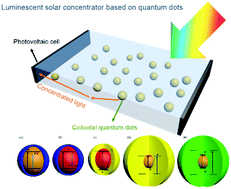当前位置:
X-MOL 学术
›
Chem. Soc. Rev.
›
论文详情
Our official English website, www.x-mol.net, welcomes your
feedback! (Note: you will need to create a separate account there.)
Harnessing the properties of colloidal quantum dots in luminescent solar concentrators
Chemical Society Reviews ( IF 40.4 ) Pub Date : 2018-06-19 00:00:00 , DOI: 10.1039/c7cs00701a Yufeng Zhou 1, 2, 3, 4 , Haiguang Zhao 5, 6, 7 , Dongling Ma 1, 2, 3, 4 , Federico Rosei 1, 2, 3, 4, 8
Chemical Society Reviews ( IF 40.4 ) Pub Date : 2018-06-19 00:00:00 , DOI: 10.1039/c7cs00701a Yufeng Zhou 1, 2, 3, 4 , Haiguang Zhao 5, 6, 7 , Dongling Ma 1, 2, 3, 4 , Federico Rosei 1, 2, 3, 4, 8
Affiliation

|
Luminescent solar concentrators (LSCs) can serve as large-area sunlight collectors, are suitable for applications in high-efficiency and cost-effective photovoltaics (PVs), and provide adaptability to the needs of architects for building-integrated PVs, which makes them an attractive option for transforming buildings into transparent or non-transparent electricity generators. Compared with traditional organic dyes, colloidal semiconducting quantum dots (QDs) are excellent candidates as emitters for LSCs because they exhibit wide size/shape/composition-tunable absorption spectra ranging from ultraviolet to near infrared, significantly overlapping with the solar spectrum. They also feature narrow emission spectra, high photoluminescence quantum yields, high absorption coefficients, solution processability and good photostability. Most importantly, QDs can be engineered to provide a minimal overlap between absorption and emission spectra, which is key to the realization of large-area LSCs with largely suppressed reabsorption energy losses. In this review article, we will first present and discuss the working principle of LSCs, the synthesis of colloidal QDs using wet-chemistry approaches, the optical properties of QDs, their band alignment and the intrinsic relationship between the band energy structure and optical properties of QDs. We focus on emerging architectures, such as core/shell QDs. We then highlight recent progress in QD-based LSCs and their anticipated applications. We conclude this review article with the major challenges and perspectives of LSCs in future commercial technologies.
中文翻译:

利用发光太阳能集中器中的胶体量子点的特性
发光太阳能聚光器(LSC)可以用作大面积的阳光收集器,适用于高效且具有成本效益的光伏(PV),并可以满足建筑师对建筑集成PV的需求,从而使其成为一种将建筑物转换为透明或不透明发电机的有吸引力的选择。与传统有机染料相比,胶体半导体量子点(QDs)是LSC的理想发射体,因为它们具有从紫外线到近红外的宽尺寸/形状/组成可调吸收光谱,与太阳光谱显着重叠。它们还具有窄的发射光谱,高的光致发光量子产率,高的吸收系数,溶液的可加工性和良好的光稳定性。最重要的是,可以设计QD以在吸收光谱和发射光谱之间提供最小的重叠,这对于实现具有大幅度抑制的重吸收能量损失的大面积LSC至关重要。在这篇综述文章中,我们将首先介绍并讨论LSC的工作原理,使用湿化学方法合成胶体QD,QD的光学性质,它们的能带排列以及能带结构和光能之间的内在联系。 QD。我们专注于新兴架构,例如核心/外壳QD。然后,我们重点介绍基于QD的LSC及其预期应用的最新进展。本文以LSC在未来商业技术中的主要挑战和观点作为本文的总结。这对于实现大面积LSC并抑制重吸收能量损失至关重要。在这篇综述文章中,我们将首先介绍并讨论LSC的工作原理,使用湿化学方法合成胶体QD,QD的光学性质,它们的能带排列以及能带结构与C的光学性质之间的内在联系。 QD。我们专注于新兴架构,例如核心/外壳QD。然后,我们重点介绍基于QD的LSC及其预期应用的最新进展。本文以LSC在未来商业技术中的主要挑战和观点作为本文的总结。这对于实现具有大幅度抑制的重吸收能量损失的大面积LSC至关重要。在这篇综述文章中,我们将首先介绍并讨论LSC的工作原理,使用湿化学方法合成胶体QD,QD的光学性质,它们的能带排列以及能带结构和光能之间的内在联系。 QD。我们专注于新兴架构,例如核心/外壳QD。然后,我们重点介绍基于QD的LSC及其预期应用的最新进展。本文以LSC在未来商业技术中的主要挑战和观点作为本文的总结。湿化学法合成胶体量子点,量子点的光学性质,能带排列以及能带结构与量子点的光学性质之间的内在联系。我们专注于新兴架构,例如核心/外壳QD。然后,我们重点介绍基于QD的LSC及其预期应用的最新进展。本文以LSC在未来商业技术中的主要挑战和观点作为本文的总结。湿化学法合成胶体量子点,量子点的光学性质,能带排列以及能带结构与量子点的光学性质之间的内在联系。我们专注于新兴架构,例如核心/外壳QD。然后,我们重点介绍基于QD的LSC及其预期应用的最新进展。本文以LSC在未来商业技术中的主要挑战和观点作为本文的总结。
更新日期:2018-06-19
中文翻译:

利用发光太阳能集中器中的胶体量子点的特性
发光太阳能聚光器(LSC)可以用作大面积的阳光收集器,适用于高效且具有成本效益的光伏(PV),并可以满足建筑师对建筑集成PV的需求,从而使其成为一种将建筑物转换为透明或不透明发电机的有吸引力的选择。与传统有机染料相比,胶体半导体量子点(QDs)是LSC的理想发射体,因为它们具有从紫外线到近红外的宽尺寸/形状/组成可调吸收光谱,与太阳光谱显着重叠。它们还具有窄的发射光谱,高的光致发光量子产率,高的吸收系数,溶液的可加工性和良好的光稳定性。最重要的是,可以设计QD以在吸收光谱和发射光谱之间提供最小的重叠,这对于实现具有大幅度抑制的重吸收能量损失的大面积LSC至关重要。在这篇综述文章中,我们将首先介绍并讨论LSC的工作原理,使用湿化学方法合成胶体QD,QD的光学性质,它们的能带排列以及能带结构和光能之间的内在联系。 QD。我们专注于新兴架构,例如核心/外壳QD。然后,我们重点介绍基于QD的LSC及其预期应用的最新进展。本文以LSC在未来商业技术中的主要挑战和观点作为本文的总结。这对于实现大面积LSC并抑制重吸收能量损失至关重要。在这篇综述文章中,我们将首先介绍并讨论LSC的工作原理,使用湿化学方法合成胶体QD,QD的光学性质,它们的能带排列以及能带结构与C的光学性质之间的内在联系。 QD。我们专注于新兴架构,例如核心/外壳QD。然后,我们重点介绍基于QD的LSC及其预期应用的最新进展。本文以LSC在未来商业技术中的主要挑战和观点作为本文的总结。这对于实现具有大幅度抑制的重吸收能量损失的大面积LSC至关重要。在这篇综述文章中,我们将首先介绍并讨论LSC的工作原理,使用湿化学方法合成胶体QD,QD的光学性质,它们的能带排列以及能带结构和光能之间的内在联系。 QD。我们专注于新兴架构,例如核心/外壳QD。然后,我们重点介绍基于QD的LSC及其预期应用的最新进展。本文以LSC在未来商业技术中的主要挑战和观点作为本文的总结。湿化学法合成胶体量子点,量子点的光学性质,能带排列以及能带结构与量子点的光学性质之间的内在联系。我们专注于新兴架构,例如核心/外壳QD。然后,我们重点介绍基于QD的LSC及其预期应用的最新进展。本文以LSC在未来商业技术中的主要挑战和观点作为本文的总结。湿化学法合成胶体量子点,量子点的光学性质,能带排列以及能带结构与量子点的光学性质之间的内在联系。我们专注于新兴架构,例如核心/外壳QD。然后,我们重点介绍基于QD的LSC及其预期应用的最新进展。本文以LSC在未来商业技术中的主要挑战和观点作为本文的总结。









































 京公网安备 11010802027423号
京公网安备 11010802027423号